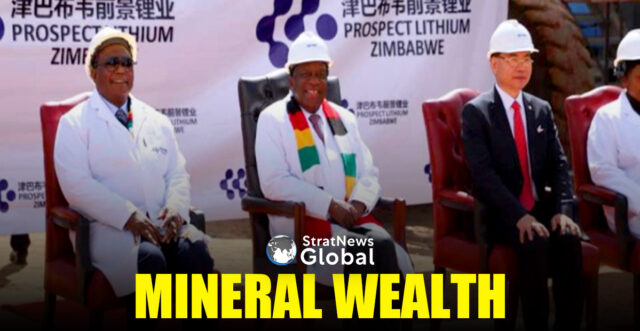At a recent OECD High-Level Dialogue on Africa in Paris, political leaders from across the continent laid out a bold aspiration: to stop being mere suppliers of raw materials and begin adding value to their critical mineral wealth.
Ghana’s Lands Minister spoke of domestic lithium refining. Nigeria’s Solid Minerals Minister called for investment in local processing. Morocco unveiled an ambitious “OTC Corridor” (Origin, Transit, and Certification) strategy to become a hub for mineral validation and transport.
But as Obert Bore, Critical Minerals Editor at The China–Global South Project, points out in a recent report, these lofty declarations were missing one crucial element: any mention of China. The world’s undisputed leader in critical mineral processing, China has not only built a commanding lead in refining cobalt, lithium, and rare earths—it has also vertically integrated these into the world’s largest electric vehicle (EV) and battery manufacturing ecosystem.
Ignoring China’s role, Bore warns, isn’t just an oversight. It risks rendering Africa’s ambitions moot. If African nations want to meaningfully participate in the global value chain for critical minerals, they must come to terms with the uncomfortable reality that China is decades ahead, both in technological capability and industrial policy.
Africa is home to some of the world’s richest mineral deposits—over 70% of global cobalt, vast lithium reserves in Zimbabwe and Namibia, and significant deposits of manganese, nickel, and rare earths. Yet its role in the global value chain remains largely extractive. The reasons are structural:
• Electricity: Mineral processing—especially battery-grade materials—requires consistent, affordable power. While China benefits from state-subsidised coal, hydro, and nuclear energy (on track to be 50% low-carbon by 2028), African nations like Zimbabwe, Nigeria, and South Africa suffer from chronic blackouts.
• Water: Processing lithium and other minerals is water-intensive. China has invested billions in water recycling and desalination. Africa faces worsening water scarcity and underdeveloped water infrastructure.
• Technology: China has spent decades mastering and localising refining tech. African countries, by contrast, lack the machinery, automation, and skilled workforce to scale up midstream (chemical refining) or downstream (battery manufacturing) operations.
• Capital and Infrastructure: Setting up refineries, smelters, and transport corridors requires massive investment—something most African nations struggle to attract or sustain. Regional fragmentation further complicates the development of integrated value chains.
Beijing controls over 60% of global lithium refining, 70% of cobalt processing, and nearly 90% of rare earth refining. Its dominance isn’t accidental—it’s the result of strategic, long-term industrial planning, bolstered by state financing, international acquisition of mineral assets, and export restrictions on key technologies.
China has also been pragmatic. While some Chinese firms have partnered with African governments to build local processing facilities—such as the lithium plant in Zimbabwe—these projects often stop at low-grade processing (like converting ore to concentrate), far from high-value outputs like lithium hydroxide or battery precursors.
Moreover, China has no incentive to enable serious competition. Its current export controls restrict the transfer of high-end refining technologies, especially those with potential military or dual-use applications.
As Morgan Bazilian, Director of the Payne Institute at the Colorado School of Mines, notes, the refining “midstream” is the most strategically important part of the supply chain—and China intends to keep its grip tight.
Bore suggests a more grounded approach: rather than attempting to replicate China’s vertically integrated model, Africa should focus on regional hubs in mineral-rich corridors—like the DRC-Zambia Copperbelt or the Zimbabwe-Namibia lithium belt. Pooling infrastructure, harmonising regulations, and investing in shared facilities could create the scale and stability needed to make value addition viable.
The African Union’s Green Minerals Strategy, adopted in 2024, provides a framework for such regional cooperation. But implementation will require more than summits and speeches. It will demand foundational investments in hydropower (e.g., the Inga Dam in DRC, Mozambique’s Cahora Bassa), logistics, and human capital.
Africa must also pursue selective strategic partnerships—not just with China, but with India, the EU, South Korea, and Japan—focused on technology transfer, skill-building, and co-investment in midstream processing. Joint ventures with Chinese universities and tech firms could help build local expertise in automation and mineral engineering.
There’s growing geopolitical interest in Africa’s mineral wealth. The U.S. Inflation Reduction Act (IRA), the EU’s Critical Raw Materials Act, and India’s outreach under its own mineral security strategies all reflect a desire to diversify away from China. But even so, Africa’s path to industrial self-reliance will be slow, capital-intensive, and uneven.
African leaders must stop using “value addition” as a slogan and start treating it as a serious, long-term national and regional project. That means making tough policy choices, investing in basics like power and water, and creating incentives for investors who can bring not just money, but also know-how.
Most importantly, it means dropping the diplomatic politeness and facing the China question head-on.
As Bore writes, “If the continent is serious about capturing more value, it must stop pretending that China isn’t decades ahead.”
The road to mineral independence runs not around China—but, strategically, through it.
In a career spanning three decades and counting, Ramananda (Ram to his friends) has been the foreign editor of The Telegraph, Outlook Magazine and the New Indian Express. He helped set up rediff.com’s editorial operations in San Jose and New York, helmed sify.com, and was the founder editor of India.com.
His work has featured in national and international publications like the Al Jazeera Centre for Studies, Global Times and Ashahi Shimbun. But his one constant over all these years, he says, has been the attempt to understand rising India’s place in the world.
He can rustle up a mean salad, his oil-less pepper chicken is to die for, and all it takes is some beer and rhythm and blues to rock his soul.
Talk to him about foreign and strategic affairs, media, South Asia, China, and of course India.





